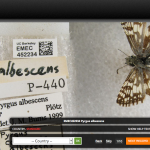
Say what? An elephant uses its feet and trunk to listen to seismic sound
Photo credit: O’Connell & Rodwell
Before I was old enough to be embarrassed by such matters, I loved listening to my father’s loud conversations with elephants at the zoo. Egged on by my sister and I, he would purse his lips together and blow his cheeks out, making a loud trumpet that commanded the attention of everyone at the exhibit. Occasionally, the elephants would respond with a weary glance in our direction, which I interpreted as a sure sign of approval for my father’s interspecies communication skills.
It turns out the trumpeting sounds my father attempted to imitate only represented the tip of the iceberg in elephant communication. In a study published last month in Bioacoustics, a team led by Stanford University ecologist and otolaryngolist Caitlin O’Connell-Rodwell showed that elephants communicate as a group using low frequency rumbles barely detectable by the human ear. Her team’s research adds to a growing body of knowledge about the complexity of elephant communication—a field that may contribute to novel strategies for helping the deaf.
While humans can hear the higher harmonics of an elephant rumble, the majority of the sound is below the threshold of our detection. Akin to the “sound” of an approaching earthquake, the rumbles can still be experienced by what some have described as a “weird feeling,” or pressure in the chest.
O’Connell-Rodwell’s most recent discovery — observed from atop a solar-powered tower in Etosha National Park in Namibia — revealed that the three most dominant elephants in the herd use orderly, coordinated, and repetitive rumble conversations to achieve certain tasks like leaving a watering hole. She proposes that the looping, repetitive nature of these dialogues may work to increase the broadcast distance of the conversations, thus alerting distant herds that space is freeing up at the watering hole.
To add to the elephant’s communicative mystique, researchers noticed long ago that the animals appeared to be listening with their feet. O’Connell-Rodwell’s team eventually showed that vocalized rumbles travel through the ground where they are sensed “seismically” by other elephants as far as 20 miles away. Judging by their big ears (Dumbo actually flew, remember?), elephants also hear plenty of sound through the air, but seismic “ground sound” might be preferable in situations when wild weather or trees from dense forests scatter sound waves in the air.
While elephants use the seismic sense to chat about subjects such as water hole etiquette, they also use this form of communication to respond to threats. This group of elephants take a vigilant stance and cluster into family groups after hearing an alarm call from a familiar herd broadcast underground.
Elephants detect vibrations in the ground in two different ways—only one of which involves the ear. Bone conduction, which does use the ear, works by transmitting sound waves from the ground through the feet, up the bones, and ultimately into the inner ear. There, the vibrations tickle the tiny, exquisitely sensitive hairs that blanket a French horn-like structure called the cochlea, leading to the stimulation of nerves that transmit the sound to the brain. Alternatively, vibration-sensitive receptors found in the elephant’s feet and trunk transmit sound to the brain without the need for an ear at all. These receptors – called Pacinian corpuscles — form the basis of the sense of touch, so elephants could quite literally be “touching sound.”
The ability to touch sound, it turns out, is not restricted to elephants or to humans on LSD. In fact, like elephants, we humans have Pacinian corpuscles that are sensitive enough to detect sound waves. Found in our skin and connective tissues, the corpuscles look much like the cross-section of an onion with a root that links up to nerves transmitting the sensation of touch. When submerged in water, the human finger can detect sound waves through these tiny sensors.
This so-called vibrotactile sense may one day serve as a substitute for functional ears in the severely deaf. Currently, cochlear implants dominate the treatment landscape for severe deafness. They work by stimulating the auditory nerve, thus bypassing the need for a functional cochlea. Unfortunately for people who have nerve damage, these implants are worthless. Even for those with functional nerves, cochlear implants are no substitute for the sensitive hairs that blanket a natural cochlea.
O’Connell-Rodwell, in collaboration with engineers at Hnu Medical, is in the early stages of developing a prosthesis called the “Hearing Hand.” The glove-like device will serve to maximize vibrational sensations, thus allowing those with damaged ears to hear through their hands instead. “The best way to think of the hand is as if you were to sit on top of a subwoofer while music is being played. You get the beat of the music, the rhythm, and the pitch differences,” explained O’Connell-Rodwell. Given that speech is far simpler in many ways than music, she is hopeful that the Hearing Hand could one day allow people to listen in to conversations without the use of their ears entirely.
Perhaps even those of us blessed with working ears will want to tap into the vibrational sense. I, for one, would love to know what sound really feels like.







Very nice post, Jessica. Vibrational communication in the animal kingdom is one of those can’t-miss stories for readers! Your piece reminded me of a Q&A from AAAS 2011 written by Nadia Drake, about the golden mole: http://scicom.ucsc.edu/publications/QandA/2011/narins.html